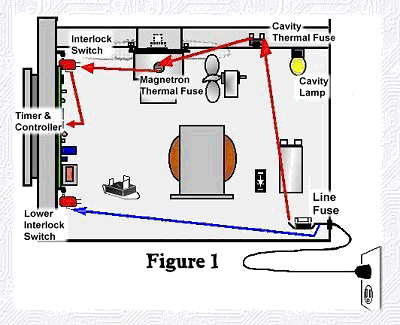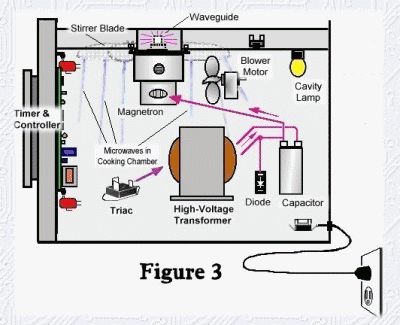
Microwave ovens use combinations of circuits and mechanical devices ot produce an output of microwave energy.
There are two main sections in the microwave: The control section, and the high voltage section.
The control section consists of the following:

As seen in the picture above, when you turn on your microwave oven, electricy from the wall outlet travels through the power cord and enters the microwave oven through a series of fuse and safety protection circuits(circuits which are designed to deactivate the oven in the event of an electrical short or if an overheating occurs).
Then assuming that all systems are normal and working correctly, the electricity passes through to the interlock and timer circuits. When the oven door is closed, an electrical path is also established through a series of safety interlock switches(The purpose of the interlock system is to interrupt the production of microwave energy when the oven door is opened, and similarly, to prevent any microwave output until the door is firmly and safely closed). Setting the oven timer and starting a cook operation extends this voltage path to the control circuits.
In the high-voltage section, the high voltage transformer serves to increase the typical household voltage(about 115 volts), to a amazingly high amount of about 3000 volts! While this voltage is strong enough to kill, it is just what the magnetron tube needs to do its job--which is to dynamically convert high voltage in to undulating waves of electromagnetic cooking energy(in other words, to convert the high voltage into microwave).
 The microwave energy is transmitted into a metal channel called a waveguide, which feeds the energy into the cooking area where it encounters the slowly revolving metal blades of the stirrer blade. The purpose of the stirrer blade it to evenly disperse the microwave energy evenly throughout all areas of the cooking compartment. Some waves go directly toward the food, other bounce off the metal walls and flooring; and, thanks to the special metal screen with small holes, microwaves also reflect off the door. All microwave energy remains inside the cooking cavity. When the door is opened, or the timer reaches zero, the mircowave energy stops.
The microwave energy is transmitted into a metal channel called a waveguide, which feeds the energy into the cooking area where it encounters the slowly revolving metal blades of the stirrer blade. The purpose of the stirrer blade it to evenly disperse the microwave energy evenly throughout all areas of the cooking compartment. Some waves go directly toward the food, other bounce off the metal walls and flooring; and, thanks to the special metal screen with small holes, microwaves also reflect off the door. All microwave energy remains inside the cooking cavity. When the door is opened, or the timer reaches zero, the mircowave energy stops.
That is a more technical, and mechanical explanation of how a microwave works. So next time you forget about what is cooking your food just look up this page, and hope you can understand what I am saying.
Note: The pictures are credited to Jay Gallawa